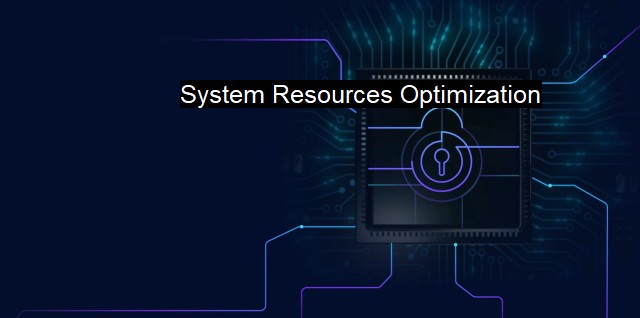What is System Resources Optimization?
Enhancing Cybersecurity in the Digital Age: The Importance of System Resource Optimization
System Resources Optimization is a pivotal concept within the domain of cybersecurity and antivirus. It is the method of streamlining a functioning system to exploit its resources and reach maximum possible efficiency. It involves reshuffling and configuring a system to be less susceptible to potential threats and attacks.In cybersecurity and antivirus settings, System Resources Optimization revolves around the manner how to informs system bears a multitude of performance metrics, systems run smooth, free from the detrimental impact of any present or potential security threats. The crucial roles of System Resources Optimization in this setting become more evident when you think of multifaceted systems entangled through shared access to resources by users and applications operating those systems.
System Resources Optimization, in relation to antivirus programs, will focus on enhancing the security suite's real-time scanning and detection abilities while ensuring minimal consumption of system sources. This strategy is targeted to ensure that the system resources, like memory, CPU usage, network bandwidth, among others, are utilised efficiently without compromise on the antivirus software performance and overall system performance.
Antivirus software traditionally runs in the background, continuously checking the system for threats. Without proper optimization, this could result in significant system resource use which might slow down the system and stifle other operations. But with effective optimization, the antivirus program can run an efficient scan and limit a resource's usage, freeing them for other tasks and boosting the system efficiency.
System Resources Optimization within cybersecurity and antivirus environment is essentially centred upon identifying, analysing and mitigating any potential risks, vulnerabilities or threats. An optimized system continually evolves better strategies to counter these risks and issues, aligning with the ever-changing cybersecurity landscape. The system curates more effective, efficient techniques for threat detection and elimination with fewer resource-consuming processes, thereby producing a harmonious balance between threat management and system performance.
Achieving System Resources Optimization in cybersecurity also involves the application of technologies like Artificial Intelligence (AI) and Machine Learning (ML). With these disruptive innovations, cybersecurity systems can analyse and interpret big data swiftly than ever. The system, consequently, is adapted to thwart security threats more precisely with succinct use of resource power and response times.
Even cloud technologies have driven resource optimization, exclusively when user data is at stake. With cloud security measures efficiently optimized, resources used to ensure data security within cloud servers are better managed. Security landscapes incorporate various cloud data security tools and technologies ensuring optimal resource usage while securing user data.
Optimal system performances are associated with right resource allocation - a significant aspect of System Resources Optimization. efficient resource distribution lets security systems distribute tasks and redirect resources where they are needed the most in a given scenario, effectively optimizing the overall system and its functionalities.
Reviewing these processes, it gets fairly clear that System Resources Optimization in the context of cybersecurity and antivirus is essential for a stable, safe, and foolproof user experience. It improves system responsiveness, facilitates better decision-making, enhances threat detection capabilities and ensures seamless functioning of the set systems.
System Resource Optimization, thus, is a core component in maintaining cybersecurity infrastructure in today’s digitally driven society. With the evolving sophistication and complexity of online threats, continually reassessing and optimizing how system resources are allocated deem vital for an efficiently secured systems landscape. This way, both system functionality and cybersecurity endure effectively hand in hand, making sure for secure digital experiences.

System Resources Optimization FAQs
What is system resources optimization?
System resources optimization is the process of managing and allocating computer resources, such as CPU, memory, and disk space, in an efficient and effective manner. It helps to improve computer performance, reduce errors, and prevent security threats.Why is system resources optimization important for cybersecurity?
System resources optimization is important for cybersecurity because it helps to improve the overall security posture of a computer. By optimizing resources, we can reduce the attack surface, prevent resource-intensive attacks, and improve the detection and response to security threats.What are some common system resources optimization techniques used in antivirus software?
Antivirus software often uses several system resources optimization techniques, such as real-time scanning, idle scanning, intelligent scanning, and low-level system access. These techniques help to optimize CPU, memory, and disk usage, while still providing effective malware detection and removal.How do I optimize system resources on my computer for better cybersecurity?
You can optimize system resources on your computer for better cybersecurity by implementing basic security measures such as using antivirus software, applying software updates and patches, and avoiding suspicious websites and emails. Additionally, you can optimize resources by removing unnecessary programs, disabling startup programs, and using a task manager to monitor and manage resource usage.| | A | | | B | | | C | | | D | | | E | | | F | | | G | | | H | | | I | | | J | | | K | | | L | | | M | |
| | N | | | O | | | P | | | Q | | | R | | | S | | | T | | | U | | | V | | | W | | | X | | | Y | | | Z | |
| | 1 | | | 2 | | | 3 | | | 4 | | | 7 | | | 8 | | |||||||